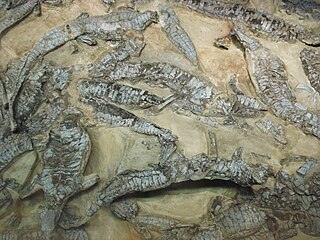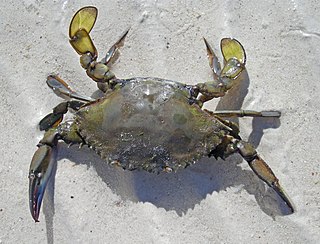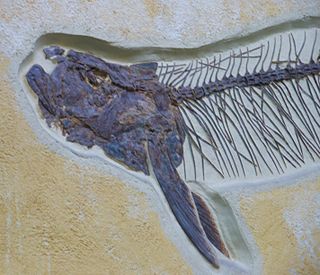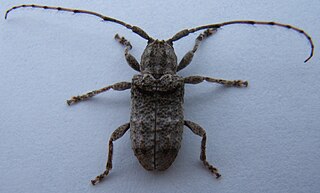
Aetosaurus is an extinct genus of archosaur reptile belonging to the order Aetosauria. It is generally considered to be the most primitive aetosaur. Three species are currently recognized: A. ferratus, the type species from Germany and Italy; A. crassicauda from Germany; and A. arcuatus from eastern North America. Additional specimens referred to Aetosaurus have been found in the Chinle Group of the southwestern United States, and the Fleming Fjord Formation of Greenland. Specimens of Aetosaurus occur in Norian-age strata.

The gray angelfish, grey angelfish or black angelfish, is a large angelfish of the family Pomacanthidae, found in the western Atlantic from New England to the vicinity of Rio de Janeiro, Brazil, and also the Bahamas, the Gulf of Mexico, and the Caribbean, including the Antilles, at depths of between 2 and 30 m. With a length up to 60 cm, this is the largest species of marine angelfish. It weighs about 2.0 kg. It feeds mainly on sponges. It is usually found in warm water, in coral reefs, and in oceans.

Callinectes arcuatus is a species of swimming crab in the genus Callinectes that lives along the Pacific coast of Central America.

The Salokko rat is a species of rodent in the family Muridae.
Taeromys is a genus of rodent in the family Muridae found exclusively in Sulawesi, Indonesia. It contains the following species:

The arcuate horseshoe bat is a species of bat in the family Rhinolophidae. It is found in Indonesia, Malaysia, Papua New Guinea, and the Philippines.
Centropogon arcuatus is a species of plant in the family Campanulaceae. It is endemic to Ecuador. Its natural habitat is subtropical or tropical moist montane forests. It is threatened by habitat loss.

Gillicus arcuatus was a relatively small, 2-metre long ichthyodectid fish that lived in the Western Interior Seaway, in what is now central North America, during the Late Cretaceous. Like its larger relative, Ichthyodectes ctenodon, G. arcuatus had numerous small teeth lining its jaws, and ate smaller fish by sucking them into its mouth. Gillicus would also filter feed and were also eaten by their own relative, Xiphactinus. In particular, one 13 feet (4.0 m) fossil specimen was collected by George F. Sternberg with another, nearly perfectly preserved 6 feet (1.8 m) long ichthyodectid Gillicus arcuatus, inside of it. The larger fish apparently died soon after eating its prey, most likely due to the smaller fish prey struggling and rupturing an organ as it was being swallowed. This fossil can be seen at the Sternberg Museum of Natural History in Hays, Kansas.

The banded angelfish, also known as the bandit angelfish and three spine angelfish, is a distinctive species fish of the family Pomacanthidae. It is endemic to deeper reefs in Hawaii and the Johnston Atoll.

Ichthyodectes is an extinct genus of Ichthyodectidae fish which lived during the Cretaceous. Fossils of the species included have been found from Canada to Texas.
Eurycleidus is an extinct genus of large-bodied rhomaleosaurid known from the Early Jurassic period of the United Kingdom. It contains a single species, E. arcuatus. Like other plesiosaurs, Eurycleidus probably lived on a diet of fish, using its sharp needle-like teeth to catch prey. Its shoulder bones were fairly large, indicating a powerful forward stroke for fast swimming.
Gogo arcuatus is a species of catfish of the family Anchariidae endemic to Madagascar where it is found in the Sandrananta River basin. It grows to a length of 18.1 cm.

Pogonocherini is a tribe of longhorn beetles of the subfamily Lamiinae.

Ecyrus is a genus of longhorn beetles of the subfamily Lamiinae, containing the following species:
Calothamnus arcuatus is a plant in the myrtle family, Myrtaceae and is endemic to the south-west of Western Australia. It is a shrub with prickly, cylindrical leaves with a slight, upward curve and bright red flowers in small groups near the older leaves.
Ecyrus hirtipes is a species of beetle in the family Cerambycidae. It was described by Charles Joseph Gahan in 1895. It is known from Guadeloupe, Barbados, Martinique, Cuba, Saint Vincent and the Grenadines, the Dominican Republic, Bahamas, Grenada, Haiti, and Puerto Rico. It feeds on Inga ingoides.
Rhinolophus procunsulis is an endangered species of horseshoe bat found in Malaysia. Though it was discovered in 1959, it was not recognized as a distinct species until 2013.
Ectemnius arcuatus is a species of square-headed wasp in the family Crabronidae. It is found in North America.
Spilodiscus arcuatus is a species of clown beetle in the family Histeridae. It is found in North America.
Rhinolophus mcintyrei is a species of horseshoe bat that is endemic to Papua New Guinea.










